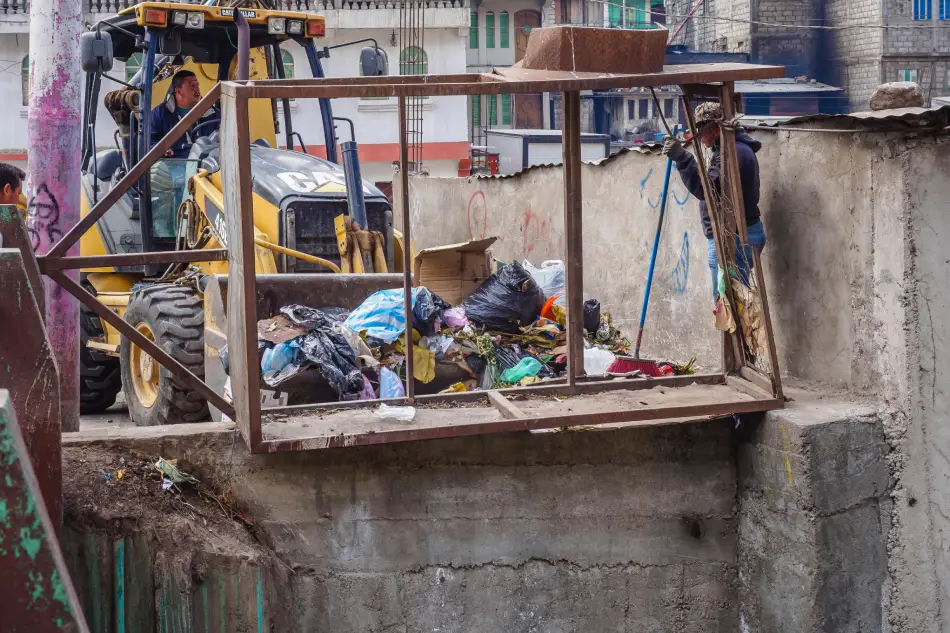Creatment and Optimization” are two key words in the context of construction waste management. The construction industry, playing a vital role in the global economy and in the creation of infrastructure, housing, and commercial buildings, faces a significant dilemma regarding waste management. While it is an essential engine for economic and social development, its production also generates a considerable amount of waste. Construction and demolition waste (CDW) represent a growing concern due to its both economic and environmental consequences.
In this context, we will explore the complex relationship between construction and CDW management, highlighting its impact on the environment and sustainability, while examining the available solutions and approaches to address this growing challenge.
Scope of the Problem

Construction and demolition waste include a wide variety of materials, such as concrete, wood, metal, glass, plastic, and mixed construction materials. In the United States alone, it is estimated that CDW represents approximately 40% of the waste generated annually. This translates to millions of tons of construction waste.
The problem with CDW is that, if not managed properly, it can have a significant impact on the environment. Improper disposal of these wastes in landfills can contaminate soil and water, releasing harmful chemicals. Additionally, the production of new construction materials from natural resources depletes resources and emits large amounts of greenhouse gases. To better understand the magnitude of this problem, it is important to examine some key data and statistics:
Waste Volume: As mentioned earlier, CDW represents approximately 40% of the waste generated in the United States; globally, the total amount of CDW is even higher.
Continued Growth: The construction industry is continually growing worldwide. As more buildings, roads, bridges, and other infrastructures are constructed, the amount of generated CDW also increases. This puts additional pressure on waste management.
Environmental Impact: CDW can have a significant environmental impact if not managed properly. Improper disposal in landfills can contaminate soil and water with toxic substances such as heavy metals and chemicals used in construction. Furthermore, the production of new construction materials from natural resources contributes to environmental degradation.
Use of Natural Resources: The production of new construction materials from natural resources is resource-intensive. For example, the manufacturing of cement, an essential component in construction, requires the extraction of large amounts of limestone and the emission of greenhouse gases.
Landfill Space Shortage: The constant increase in CDW is depleting available space in landfills. This poses long-term waste management issues and may lead to the opening of new landfills, which, in turn, has environmental and economic implications.
Public Health Impact: Exposure to poorly managed construction waste can have negative impacts on public health. Toxic waste can seep into groundwater, affecting the quality of drinking water. Additionally, the inhalation of dust and particles in the air during demolition or CDW handling can have detrimental effects on the health of construction workers and nearby communities.
Regulations and Standards: Given the magnitude of the problem and its implications for health and the environment, many jurisdictions have implemented strict regulations and standards related to CDW management. This includes source separation, recycling, and proper disposal requirements. Non-compliance with these regulations can result in fines and penalties for construction companies.
Importance of Proper Management
Efficient management of construction waste is of utmost importance for various reasons. Firstly, it has a significant environmental impact by reducing soil, water, and air pollution, as well as contributing to the conservation of natural resources by decreasing the need to extract new materials. Additionally, this practice generates significant economic savings for construction companies by reducing waste disposal costs and utilizing recycled or reused materials. Compliance with government regulations and maintaining a good business reputation are other key factors, as companies committed to sustainable practices often enjoy a competitive advantage and greater customer preference.
Lastly, construction waste management aligns with the principles of the circular economy, promoting efficiency and sustainability in the construction industry while contributing to the reduction of greenhouse gas emissions.
Construction Waste Treatment Strategies

To effectively address the issue of construction waste, it is necessary to implement appropriate treatment strategies. These strategies may include reuse, recycling, and source reduction. Below, we will explore these strategies in more detail:
Reuse
Reuse involves taking components or construction materials from existing structures and using them in new construction projects. This not only reduces the amount of waste generated but also saves resources and energy by avoiding the manufacturing of new materials. Examples of items that can be reused include doors, windows, wooden beams, bricks, and flooring.
Recycling
Recycling is another effective strategy for managing construction waste. It involves the collection and processing of used construction materials to produce new materials or products. For example, concrete and asphalt can be crushed and recycled for use in new road surfaces. Metal and glass are also common recyclable materials in construction.
Source Reduction
Source reduction refers to the practice of minimizing the amount of waste generated in the first place. This can be achieved through careful project planning, purchasing materials with less packaging, and efficient material management at the worksite. Source reduction is an important strategy as it prevents waste generation rather than dealing with it once it has occurred.
Advanced Waste Treatment Technologies
In addition to basic construction waste treatment strategies, there are advanced technologies that can further optimize waste management. Some of these technologies include:
On-site Separation
On-site separation involves the implementation of sorting and separation systems at the construction site. This allows materials to be efficiently sorted and stored by type, facilitating subsequent recycling and reuse. Workers can categorize construction materials as structures are dismantled or demolished.
Mobile Crushers
Mobile crushers are machines that can be transported to the construction site to crush construction materials such as concrete and asphalt. This reduces the need to transport large amounts of material to off-site recycling facilities and saves transportation costs.
Tracking Technology
Tracking technology is used to monitor and trace the flow of construction waste from generation to final disposal. This helps ensure that materials are handled properly and are recycled or reused to the extent possible. It also allows for more precise tracking of waste volumes and associated costs.
Benefits of Waste Treatment and Optimization
The treatment and optimization of waste bring about a range of substantial and multifaceted benefits encompassing environmental, economic, and social aspects. Firstly, this practice has a positive impact on the environment by reducing the amount of waste sent to landfills and the pollution associated with its disposal. By recycling and reusing construction materials, the need to extract natural resources is diminished, preserving ecosystems and reducing the ecological footprint of the construction industry. Additionally, proper management contributes to the reduction of greenhouse gas emissions by decreasing the energy required to produce new materials.
From an economic perspective, it offers several financial advantages. Construction companies can experience a significant reduction in waste disposal costs, enhancing project profitability. Furthermore, the sale of recycled or reused materials can generate additional income. This translates to greater resource management efficiency and optimization of available resources. Ultimately, these practices can increase the competitiveness and financial stability of construction companies.
In the regulatory realm, waste treatment and optimization enable companies to comply with government regulations and avoid legal penalties. This ensures compliance with environmental laws and ensures that construction operations unfold responsibly and sustainably. Good waste management also contributes to improving the corporate image of companies, leading to increased recognition and customer preference. Companies committed to sustainable practices and responsible waste management often enjoy a positive reputation in the market.
Challenges and Limitations

Despite its benefits, the treatment and optimization of construction waste also face challenges and limitations that must be addressed to achieve effective and sustainable management. Some of the main challenges include:
Material Complexity: Products resulting from construction are diverse and may contain a wide variety of materials, from wood and concrete to hazardous chemicals. Sorting and separating these materials can be complicated and costly.
Initial Costs: Implementing facilities and technologies for waste treatment and optimization may require a significant capital investment. This can be a barrier for small construction companies.
Education and Training: To adopt effective material management practices, construction personnel must receive adequate training. Lack of knowledge and awareness about best practices can be an obstacle.
Logistics and Transportation: Managing construction materials requires an efficient system for collecting and transporting materials to treatment facilities. Logistic challenges can increase costs and delay the process.
Changing Regulations: Regulations on material management may vary by location and change over time. Staying updated and complying with regulations can be a challenge for construction companies.
Resistance to Change: Some companies may resist changing their traditional practices and adopting material treatment and optimization methods. This may be due to a lack of awareness or the perception of additional costs.
Technology and Processing Capacity: The availability of advanced technologies for material treatment may vary by location. Lack of access to suitable treatment facilities can limit the ability to effectively manage materials.
Variability in Material Quality: The quality and quantity of construction products can vary from one project to another. This makes planning and implementing treatment strategies more challenging.
Construction Culture: In some cultures and regions, material management practices may not be a priority or may even be ignored. Changing mindsets and promoting sustainability can be a cultural challenge.
Short-Term Economic Effects: Although material treatment and optimization can generate long-term savings, some companies may be concerned about initial costs and not see immediate benefits.
Despite these challenges, it is crucial to address them to promote effective management of construction products. Investing in advanced technologies, personnel training, and collaboration among stakeholders are key approaches to overcoming these limitations and advancing toward more sustainable practices in the construction industry.
Education and Awareness

Education and awareness play a crucial role in promoting proper management of construction waste products. This includes:
Professional Training
It is essential to train construction professionals, such as architects, engineers, and contractors, in sustainable material management practices. This may involve incorporating sustainability into their training and certification programs.
Public Information
Informing the general public about the relevance of proper construction material management and how they can contribute to it is important. This can be achieved through awareness campaigns and public education programs.
Collaboration with Educational Institutions
Educational institutions, such as schools and universities, can play a key role in promoting sustainable practices in construction. This includes integrating sustainability into educational programs and research projects related to the management of construction waste products.
Conclusion
Proper management of construction materials is essential to address environmental, economic, and social challenges in the construction industry. This practice not only reduces negative environmental impacts by minimizing the amount of materials sent to landfills and promoting reuse and recycling but also generates economic savings for construction companies by reducing material disposal costs and increasing revenues through the sale of recycled materials.
Additionally, proper material management is essential to comply with government regulations and maintain a good corporate reputation, translating into a competitive advantage. Education and awareness are key components in promoting sustainable practices in construction, empowering professionals, informing the public, and collaborating with educational institutions.
As we move towards a more sustainable future, challenges and trends are expected, including increased use of recycled materials, adoption of the circular economy, development of innovative material treatment technologies, and increased collaboration among stakeholders. Ultimately, proper management of construction materials is essential for ensuring long-term sustainable development and contributing to the preservation of our environment and resources.







Related
Gravity Retaining Walls
What are Anchored Retaining Walls?
Methods for Paver Calculation – Civil Engineering